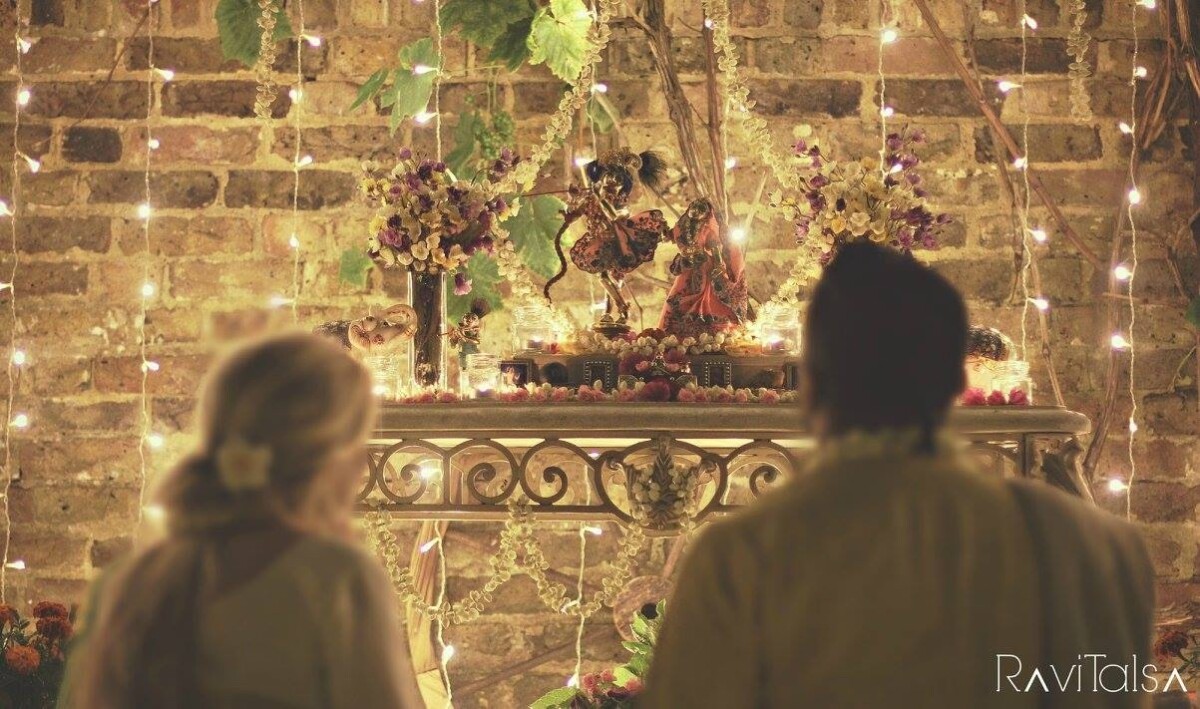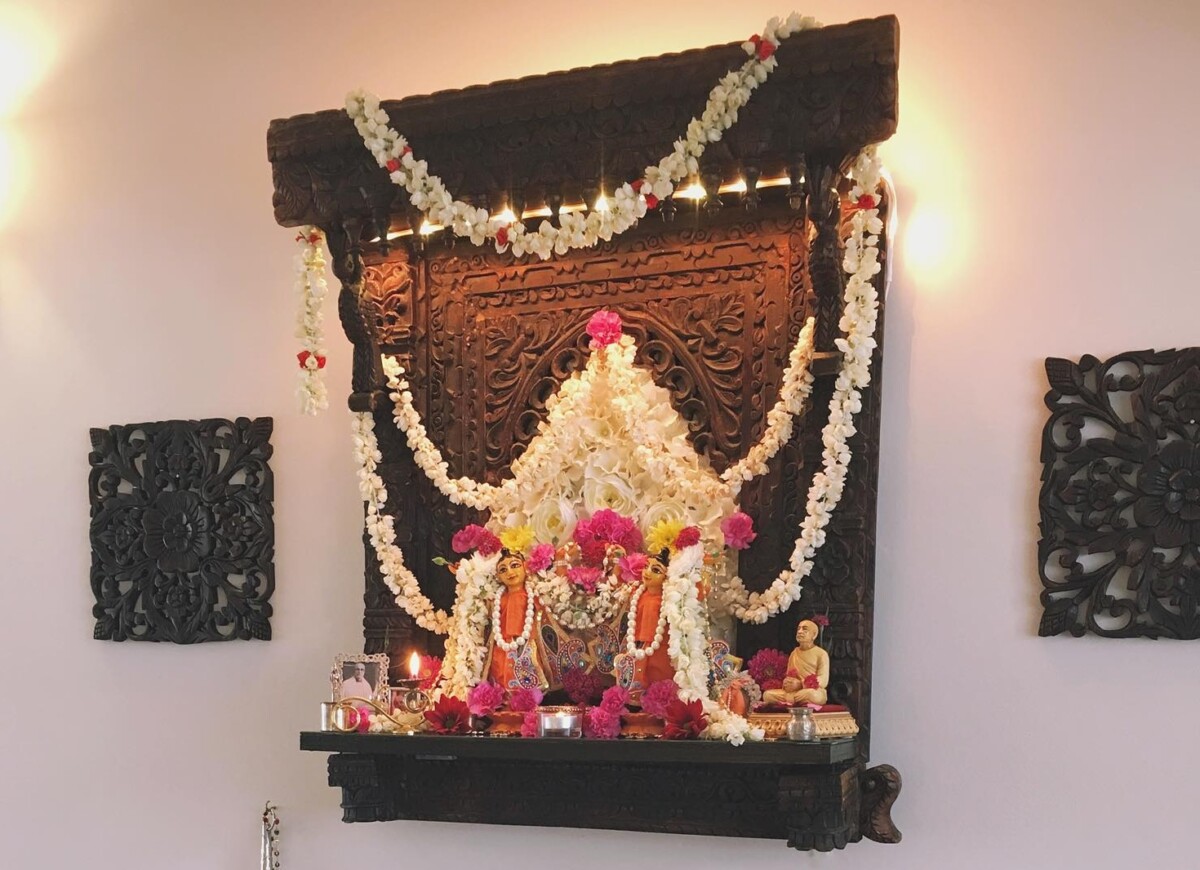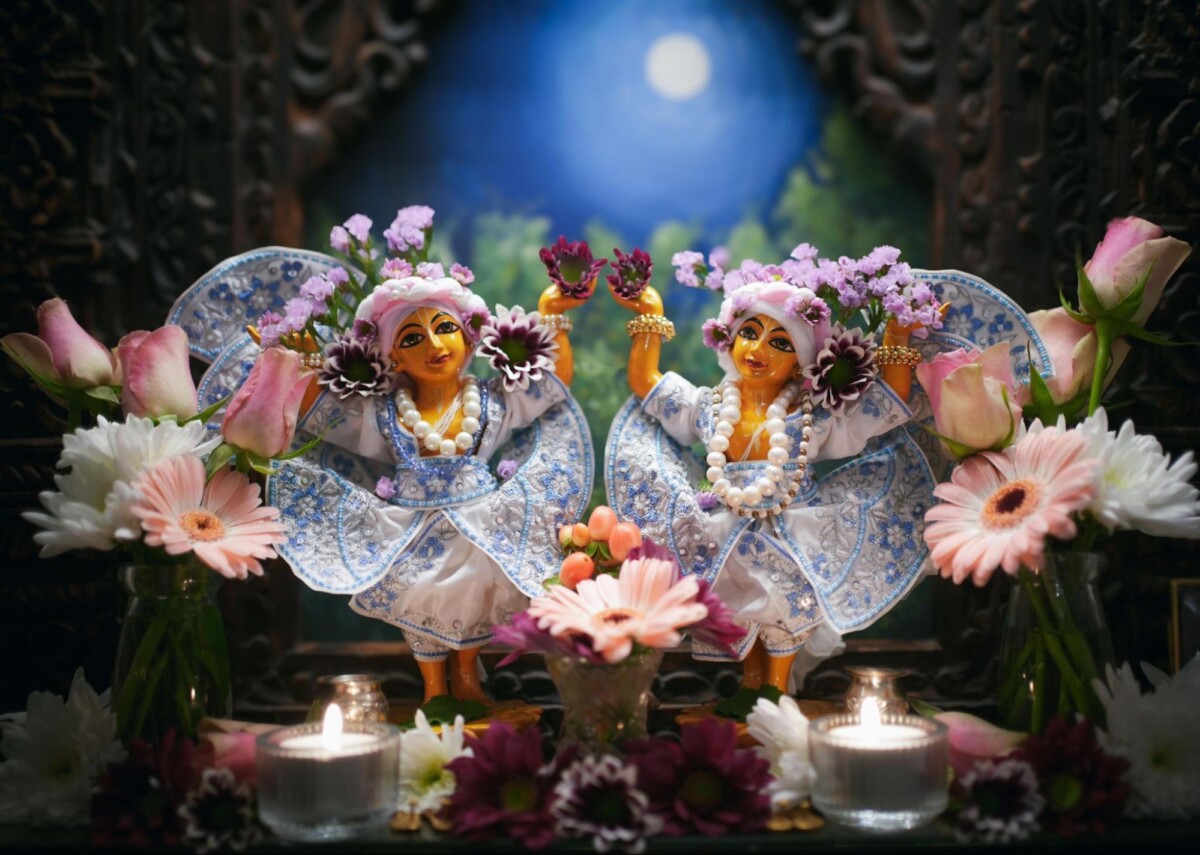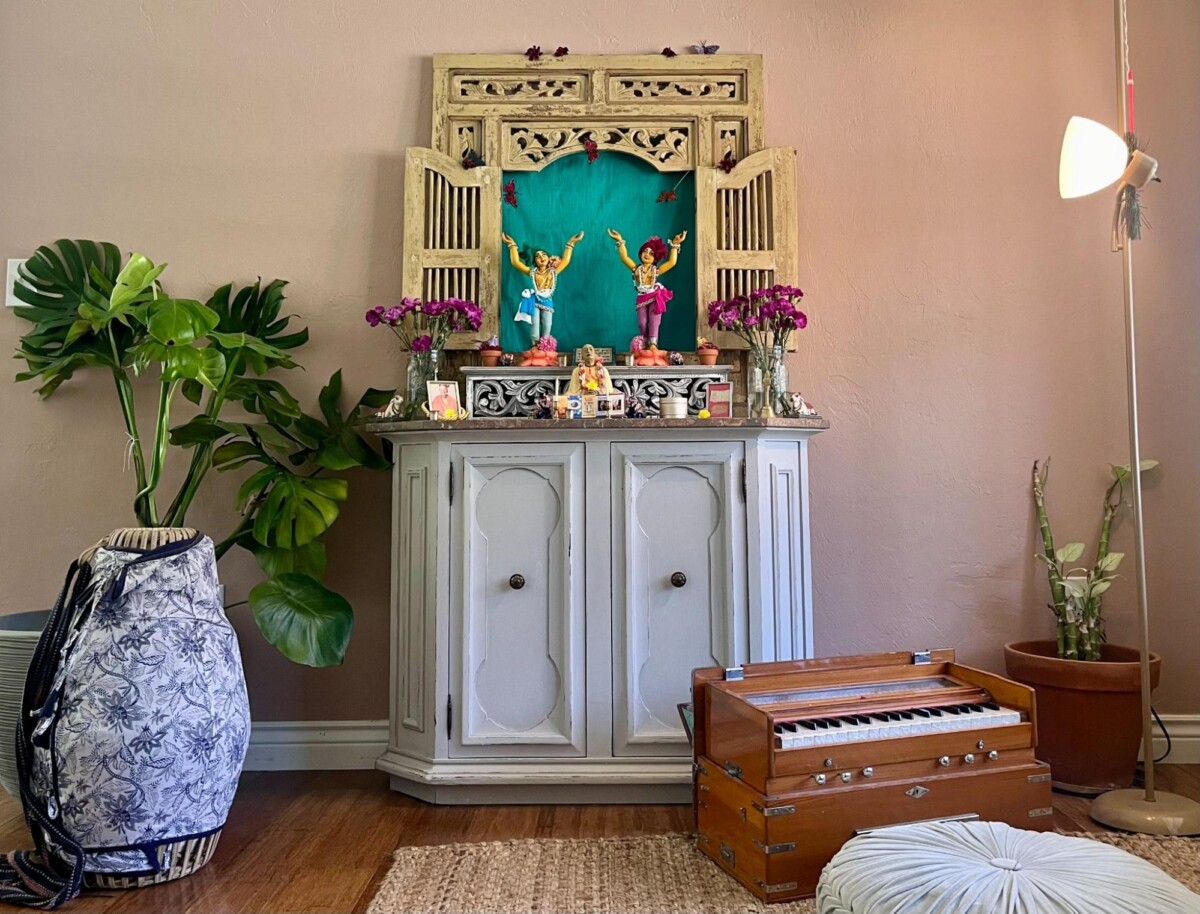

A couple takes darshan of Radha and Krishna icons at a home mandir.
Contrary to popular perception, Ancient India was a highly sophisticated civilization, responsible for a medley of pivotal scientific achievements in fields of mathematics, medicine, astronomy, and beyond.
From inventing the decimal system, to producing the first detailed text of surgical procedures, to generating the first accurate calculations of the planets and their movements, these breakthroughs were more than just steps toward a brighter future of worldly advancement. They were explorations into the mysteries of the universe, providing glimpses of the workings of creation and the Divine power behind it.
Fueled, thus, by an ethos of understanding our relationship to this power, Hindus, despite their empirical prowess, didn’t focus their societies around sensory pursuits, but constructed them, rather, for the purposes of facilitating spiritual growth. A short stroll down the country’s typical street and this truth is plain to see — be it the revered symbols adorned on various homes and buildings, the bustling ghats (sacred bathing spots) situated along numerous lakes and rivers, the periodic processions in respect of different gods and goddesses, or the devotional chants and music that ring from one destination to the next.
Divinity, according to many Hindu traditions, can be perceived anywhere and everywhere, yet these reminders serve as powerful magnets that pull our focus back to what really matters. And though, for most of us who don’t actually live in India, they can be hard to come by amidst life’s volatile demands, there is one we can still turn to no matter where we reside: a temple.
While the word might conjure in the mind grandiose images of majestic structures pure and immaculate, temples, known more accurately as mandirs, or an “abode that is honored,” aren’t about style, but intention. Standing throughout India countless in number, they are, in essence, sanctuaries of sacred space where one can tune into their spiritual practice, free from the tempestuous storm of material struggles. Even, therefore, if such a place doesn’t exist near you, access to one is still easily had — all you have to do is create it.
Ultimately, there are no hard-and-fast rules, as this space can be made no matter where a person lives. Assuming, however, you want to maximize its effectiveness, following some basic guidelines can help. So, if like the ancients, you’re ready to have an area in your home that can give you the continual recharge and refocus needed to remind you of what’s important in life, look no further.
We’ve got five easy steps for you. Just keep on reading.
1) Pick a location
Success in spiritual life requires internal balance, a feat more easily attained by practicing it externally. Just, therefore, as yogic postures can help one find harmony within, so too can adjusting other aspects of one’s physical environment.
Because of this, Vastu Shastra (the traditional system of architecture used in Ancient India) emphasizes the importance of directional orientation and the role it plays in cultivating an atmosphere conducive for various activities. When it comes to creating a temple space, it should thus be no surprise there are a number of recommendations to observe in terms of location.
Generally speaking, it’s considered ideal to place a mandir in the northeast corner of the home, as it’s connected to Ishana, a form of Shiva associated with wisdom, knowledge, prosperity, and abundance. Furthermore, if you can have it facing west, so when you pray you’re facing east where the sun casts its morning rays, that is all the better, for such light is described as particularly auspicious, infusing one with a sense of tranquility, energy, and spiritual enthusiasm.
Since the south is associated with Yama, the presider of death, that direction should be avoided in all regards. Of course, depending on the size of your home, the amount of people living in it, and the space available to you, this isn’t always feasible — nor is following any of the above guidelines for that matter. If, like many, you have limited options to work with, do your best to keep the mandir in a respectable location, away from the bathroom or any other areas of unsanitary activity.
And if that too isn’t plausible, fret not. Remember, there are no rigid requirements. Find the best spot you can, try to partition it from the rest of the home in some way to make the space as immersive as possible, and honor it as you would any other temple.
The key, as mentioned, is intention. Approach the process with focus, care, and sincere devotion, and any place you pick is sure to be successful.

Gaura-Nitai icons stand on an altar mounted on the wall of a home mandir.
2) Choose an altar design
A typical mandir altar generally consists of four parts: a base, an underneath storage area, pillar-like support beams, and a gopuram (a tower-like top that symbolizes the spiritual ascent towards enlightenment).
Whether you have space for large and ornate, or room enough only for small and straightforward, structures made of natural materials are always best, since they evoke a simple and pure aesthetic, connecting one to Mother Earth and the visceral power of her divine presence. As wood, for example, induces feelings of solace and warmth, marble of cleanliness and clarity, and stone of stability and strength, an altar becomes more than just a place to hold your murtis (venerable icons), but a transformative tool of serenity and upliftment.
Needless to say, not everyone has the money and resources to purchase or build even a basic design. Fortunately, however, this doesn’t matter. While it’s nice to have something specifically made or picked out, it’s not necessary. Makeshift altars are more than adequate, be it a small table, the top of a dresser, or any other platform.
As long as you show due respect by placing your murtis somewhere at or above eye level, have some sort of curtain or divide to cover them appropriately, and keep a designated place for your items of veneration, that’s more than enough. Do the best you can with what you’ve got, keep an open mind, and don’t sweat the small stuff.
All will fall into place from there.

A close-up of Gaura-Nitai icons at a home mandir.
3) Place icons appropriately
Once you have your altar situated and ready to go, the next step is to set up your murtis.
Often conveyed as illicit worship of false idols, Hindu veneration isn’t the misguided violation of God many in the Abrahamic traditions would have you believe. While, due to the wide pantheon, it could seem like India’s gods and goddesses are but fallacious, and even perverse, interpretations of natural forces, the truth is actually far more thoughtful and sophisticated than the unfamiliar might think.
Divinity, as described in ancient teachings, is completely beyond the purview of the physical senses, and so imperceivable in our current states. When, however, an image is created from materials like wood, stone, metal, or clay — not whimsically, but in a meticulous and exacting process, according to the guidelines of a specific tradition — this issue can be overcome.
Though seemingly mundane in appearance, such a depiction is a compassionate manifestation of the wholly spiritual, presented as an icon made approachable to the materially conditioned. And because all of us are different, relating to the sacred in various ways, these icons are fashioned in a medley of embodiments, each emphasizing unique aspects of reality’s transcendent nature.
Whoever your ishta deva, or cherished form of Divinity, is, it’s thus fitting to confer due honor by placing them at the center of your altar, signifying their presence as the focal point of your veneration. Arranging any ancillary murtis you may have on either side in an aesthetically pleasing and appropriate manner, that’s more or less all you need to know.
And should it happen no murtis are available to you, don’t worry, paintings, drawings, and pictures are fine too. But make sure their likeness is accurately portrayed — and, if you have one, consider including a photo of a mentor or guru among them.
Like any discipline, good teachers to help guide the way on your spiritual journey are invaluable. Don’t, therefore, forget to show them the gratitude and respect they deserve.

A home mandir setup centered around the veneration of Gaura-Nitai icons.
4) Cultivate a sacred ambience
All beings originate from a Divine source and are thus fundamentally spiritual in nature. Encased, however, in physical bodies, such a truth becomes blurred by the fog of material influence, making it difficult for us to perceive.
This fog, according to sacred texts, permeates all aspects of life, expressing itself in three discernable qualities, or modes, described as goodness, passion, and darkness. Just as the three primary colors mix in various ways to tint our vision of the world, the three modes tint our consciousness, shaping our habits and perception of reality.
From food to music to association to environment, the people, places, and things we expose ourselves to bring out our good, passionate, or dark side, imbuing in us a sense of clarity and peace, desire and longing, or futility and depression, respectively. Though each mode has a way of blinding us from life’s true purpose, for even peace can make us overly content and complacent, goodness, without a doubt, is most favorable for sacred endeavors.
In order, thus, to make your mandir as spiritually conducive as possible, it’s important to pay attention to detail, doing all you can to cultivate a tranquil, lucid, and thoughtful atmosphere of goodness. A nice rug and floor cushions, for example, go a long way in helping create a pleasant and comfortable place to sit in. Soothing lights are an effective tool in steadying the mind and calming the mood. And white and/or yellow implemented into any part of the decor is always encouraged, as they are uplifting hues, signifying radiance and simplicity.
If you want to go further and adorn the space with auspicious symbols like swastikas, mandalas, rangolis, or om signs, the designs and patterns of which are said to promote a state of balance, safety, prayer, and meditation, that is all the better. Provided you keep the area clean, organized, and inviting to the senses, do what works for you, feel free to get creative, and have fun with it.
Spiritual practice, after all, is ultimately meant to make you happier, so don’t be afraid to enjoy the process.

Three devotees perform kirtan in front of an image of Gaura-Nitai icons.
5) Commit to the space
Creating a home mandir is a noble accomplishment, but if you go back to your normal routine, allowing the space to collect dust after all the work you put into its completion, the effort was more or less a waste of time.
More than just an icon to admire, murtis are like honored guests in the home who are invited to bestow spiritual knowledge and guidance upon a humble host. When, therefore, we neglect their presence, choosing not to offer the kind of hospitality we would even the most casual visitor, we deprive ourselves of that connection, and the divine love, strength, and blessings that come with it.
To thus establish and nurture this connection, sacred texts recommend the tradition of puja, an especially powerful form of reverence and adoration that combines physical, verbal, mental, and vibrational techniques. A 16-step process that engages all aspects of one’s being, the objects and actions offered — like food, incense, obeisances, and kirtan, to name a few — act as vessels of devotees’ surrender, enabling them to directly interact and communicate with the Divine icon of their spiritual focus.
Though such puja can be elaborately conducted over hours during certain festivals and major life events, it can also be simplified and performed in a much shorter space of time, so that earnest followers can incorporate it into their daily schedules. Yet, if even the condensed version seems overly daunting, don’t feel discouraged. Because the ritual’s ultimate purpose is to help one convey and cultivate spiritual attachment, just try and make a sincere offering of love as best you can.
As stated in the Bhagavad Gita, if one offers even a leaf, a flower, a fruit, or water, with true devotion, it’s bound to be accepted. All that’s required is a little faith, guidance, and determined consistency, and your practice is sure to build from there.








































